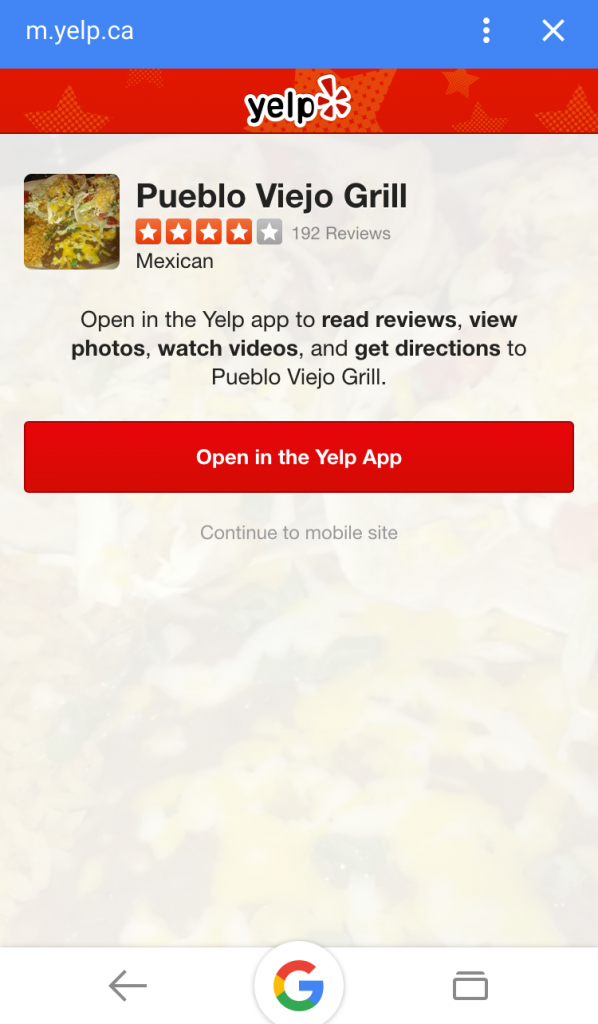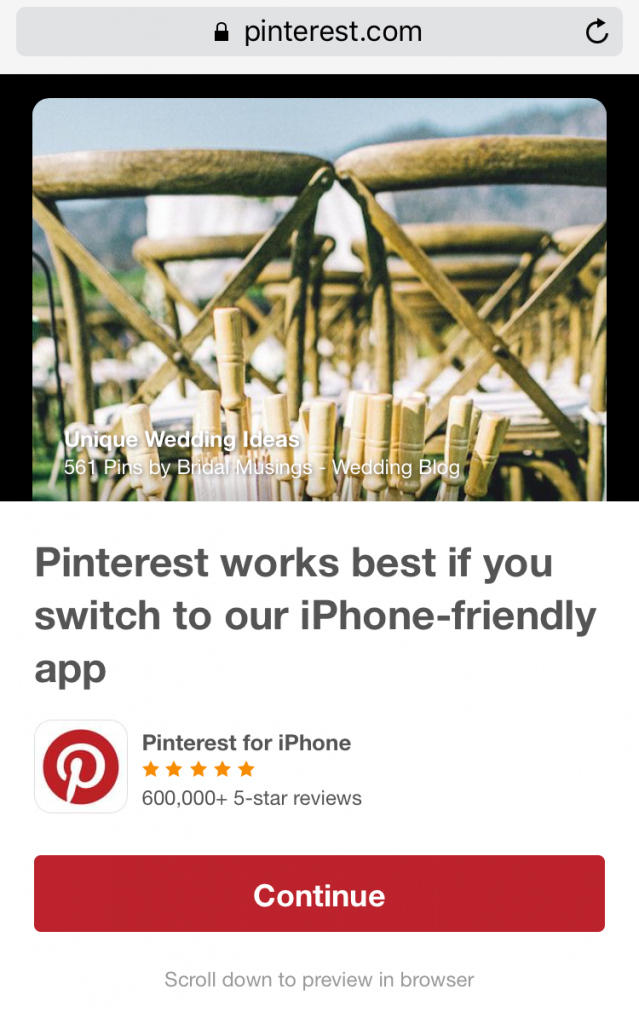 When Google decided to make app interstitials a reason for losing a page’s mobile friendly tag in the search results along with the ranking boost, Yelp’s CEO Jeremy Stoppelman was one of the very vocal critics against it. But they eventually complied and removed their app interstitial in favor of the app install banner that most sites switched to by the beginning of November 2015.
When Google decided to make app interstitials a reason for losing a page’s mobile friendly tag in the search results along with the ranking boost, Yelp’s CEO Jeremy Stoppelman was one of the very vocal critics against it. But they eventually complied and removed their app interstitial in favor of the app install banner that most sites switched to by the beginning of November 2015.
Now Yelp has changed their site in a way that they are serving visitors who click through to Yelp from the Google search results what appears to be an app interstitial. But they are doing it in such a way to circumvent Google’s app interstitial rule so that Yelp is still retaining their “mobile-friendly” tag in the Google search results as well as the associated ranking boost that all mobile friendly sites get in the mobile search results.
Here is what Yelp is serving to users when they click through from a Google search result for a business.


 It appears it is an app interstitial that requires you to either click on the “Open in Yelp app” or “Continue to the mobile site”, the latter which is also in a light grey to make it much less noticeable when compared to the large red Yelp app button.
It appears it is an app interstitial that requires you to either click on the “Open in Yelp app” or “Continue to the mobile site”, the latter which is also in a light grey to make it much less noticeable when compared to the large red Yelp app button.
The Yelp app option brings up the App Store, while choosing the mobile option brings up a new page. But because of how Yelp is formatting this “interstitial”, they are keeping the mobile friendly tag and the ranking boost.
When you look at this page in the Google search results, it shows that the page is mobile friendly.
But to a user, this is not a good user experience from a Google search result, and exactly the kind of thing Google was targeting when they made the change where app interstitials would no longer be considered mobile friendly. Bing is also showing Yelp as mobile friendly in their mobile search results.
When you test the page in Google’s mobile friendly tester, it also shows the page is mobile friendly, even though the screenshot included also resembles an app interstitial.
If you don’t click on either the “Open in Yelp app” or “Continue to the mobile site” links, you can scroll down and see how Yelp is actually getting around the app interstitial rule – by still putting some of the limited page information on the page, and placing it well below the fold where the majority of users would never see it, but where Googlebot does see it.
When Google made the announcement about app interstitials, they did state it included app install interstitials that hides a significant amount of content.
After November 1, mobile web pages that show an app install interstitial that hides a significant amount of content on the transition from the search result page will no longer be considered mobile-friendly. This does not affect other types of interstitials. As an alternative to app install interstitials, browsers provide ways to promote an app that are more user-friendly.
So even though this isn’t a traditional app interstitial, it definitely qualifies in Google’s eyes as one.
Here is what you see if you scroll down.
If you continue to scroll down, they also gate the reviews behind the app, so if you try and view more reviews than the single one they show by clicking on the “Read More Reviews” link, it redirects you to the App Store to download the app and does not allow a non-app user to read them.
 On the desktop version, all reviews are available.
On the desktop version, all reviews are available.
Yelp is serving their version of a mobile friendly app interstitial to all mobile users with both Chrome and Safari, as well as the Google Now app. They serve to those in both US and Canada.
But if you click through to one of their pages where they list multiple businesses, such as top ____ businesses in <city> pages, on those they serve the app banner instead of the interstitial.
Before Google made the app interstitial change, I spotted a Yelp test where they were testing out this format of “app interstitial”, but it seemed to be a very limited test at that time.
I asked Google’s Nathan Johns about this at Pubcon and he said this wasn’t a very good user experience and it was something they’d likely look into. But nothing seems to have been done thus far, since Yelp is still keeping their mobile friendly tag and boost despite using a fake app interstitial.
Yelp isn’t the only site being creative with how they serve their app interstitials so they also keep the mobile friendly tag and rank boost. Pinterest is another one that now does the same thing as Yelp, where they serve what appears to be an app interstitial but if you scroll down far enough, you see the real content. But unlike Yelp, Pinterest actually states on the initial screen that visitors can scroll down to see the new content on the page.
On the tester version it says “Log in with browser” while on the one I was served, it says “scroll down to preview in browser.”
App Interstitials are Not a Penalty
It is also important to note that having an app interstitial is NOT a penalty, despite some misconceptions about whether it is or not, something Gary Illyes from Google confirmed to me on Twitter.
@jenstar no, I definitely wouldn't call it a "penalty". It's just a signal for mobile-friendly classification and that's it
— Gary Illyes (@methode) January 2, 2016
But those sites that do use an app interstitial should not display “mobile-friendly” tag in the search results, nor get the associated mobile friendly ranking boost.
Why Google Made the Change
Google targeted app interstitials last year as a poor user experience for searchers, and made the change so that searchers who saw “mobile-friendly” on a site in the search results wouldn’t have to deal with an app install interstitial being served to them prior to seeing the actual content they came for. But sites that are designing their app interstitials to deliberately flout those rules to keep both the app interstitial and the mobile friendliness not only annoy users, but also can lead to other webmasters feeling they should do it and get away with it.
Will We See a Change?
Will Google change how they determine what is an app interstitial? They made this change specifically from a user experience point of view, and these types of workarounds are not good for user experience. Since it is not a penalty, it won’t hurt Yelp and others in that regards – it won’t show up under manual actions in Google Search Console, for example. But if Google does change what they consider an app interstitial to be, it would show up as a mobile friendly error in Search Console.
Or they could make adjustments to what they see as app install interstitials – all these examples fall clearly into “mobile web pages that show an app install interstitial that hides a significant amount of content on the transition from the search result page will no longer be considered mobile-friendly.” But the formatting being used by many sites is circumventing how Google currently identifies app interstitials.
Implementation: Pinterest vs Yelp
Perhaps the Pinterest example would still be considered mobile friendly since it clearly states the content is available when scrolling down, while the Yelp example makes it seem like the only choices are installing the app or clicking to another page to view the content. After all, Google constantly makes changes to their algo based on how spammers find loopholes, so it would be no different if Google adjusts how they perceive app interstitials to take into account these situations.
Consequences of Not Being Mobile Friendly
There are other potential side effects to a site no longer being considered mobile friendly. If they lose the mobile-friendly tag and boost, they could end up dropping in the search rankings, especially in competitive searches where Yelp often outranks even the businesses own name that was searched for. Then of course is the potential CTR loss from searchers who avoid non-mobile-friendly results if possible.
Yelp falls just outside the top ten sites worldwide for traffic, so it is hard to imagine that Google wouldn’t change how they determine what an app install interstitial is and isn’t. And it isn’t surprising that sites are utilizing workarounds in order to run an interstitial along with getting the benefits of being mobile friendly. But when we might see a change, if we do at all, remains to be seen. But I expect as more SEOs notice Yelp’s own tactic, we will see more sites following suit.
Should You Follow Yelp’s Lead?
In the meantime, I wouldn’t suggest using this type of strategy. If and when Google makes the change, suddenly all those pages will be flagged as not being mobile friendly, and Google would need to recrawl each individual URL without the app interstitial before those pages could get the mobile friendly tag and boost back.
Jennifer Slegg
Latest posts by Jennifer Slegg (see all)
- 2022 Update for Google Quality Rater Guidelines – Big YMYL Updates - August 1, 2022
- Google Quality Rater Guidelines: The Low Quality 2021 Update - October 19, 2021
- Rethinking Affiliate Sites With Google’s Product Review Update - April 23, 2021
- New Google Quality Rater Guidelines, Update Adds Emphasis on Needs Met - October 16, 2020
- Google Updates Experiment Statistics for Quality Raters - October 6, 2020







Alan Bleiweiss says
Ah yes – the 2016 version of spam warfare has begun between Google and site owners.